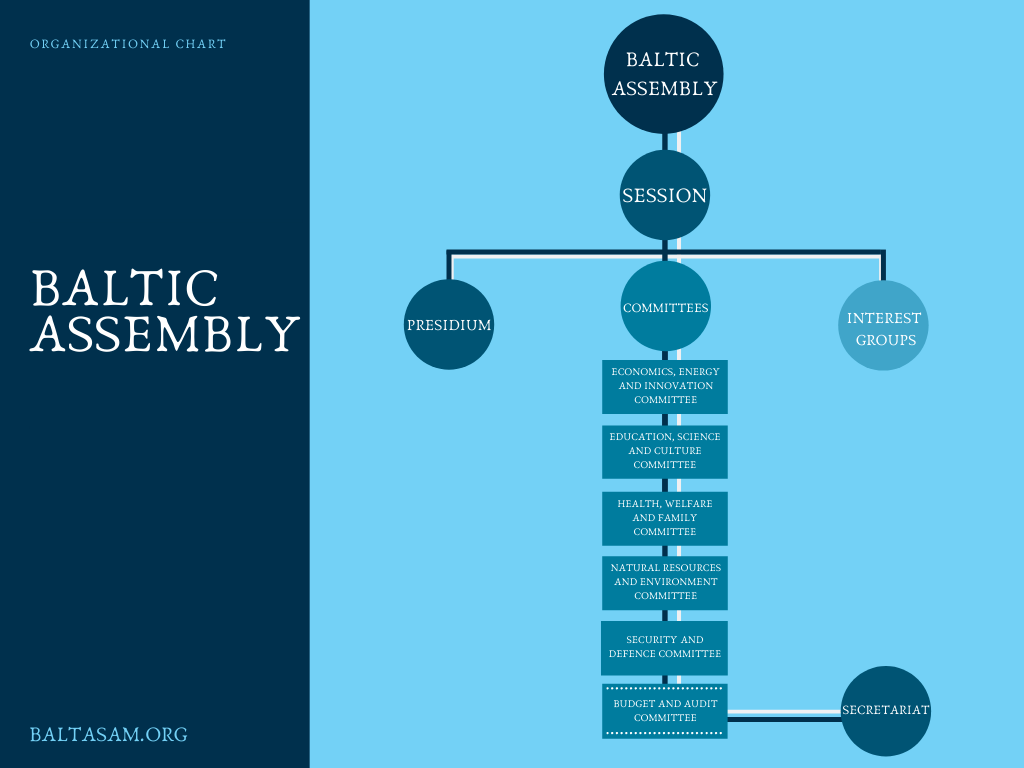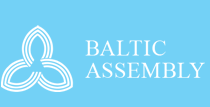How do we work?
The Baltic Assembly is an international organisation for cooperation among the parliaments of the Republic of Estonia, the Republic of Latvia and the Republic of Lithuania, founded on the basis of the Joint Decision adopted by the members of the Supreme Councils of the Republic of Estonia, the Republic of Latvia and the Republic of Lithuania in Vilnius on 1 December 1990. The Baltic Assembly functions on the basis of the Agreement of the Republic of Estonia, the Republic of Latvia and the Republic of Lithuania on Parliamentary and Intergovernmental Cooperation of the Baltic States signed in Tallinn on 13 June 1994, the Statutes and other legal acts adopted by the Baltic Assembly.
The Baltic Assembly is an entity under international law, with the headquarters of its Secretariat based in Riga, Latvia. The Baltic Assembly has its own symbols and a flag.
The overarching goal of the Baltic Assembly is to coordinate cooperation between the national parliaments of Estonia, Latvia, and Lithuania. The Baltic Assembly considers issues and various projects which are of interest to the members of the national delegations and the member states; adopts decisions in compliance with the principles of equality, mutual benefit and unanimity; and develops cooperation with other regional, international, and inter-parliamentary organisations.
Each year one of the Baltic States takes over the Presidency (see the rotation here).
The official languages of the Baltic Assembly are Estonian, Latvian and Lithuanian. Official language of the written materials and official correspondence is English. Other languages might be used in the cases specified by agreement among the delegations.
To allocate financing required for its work, the draft budget of the Baltic Assembly for the coming year is approved during its annual session. Decisions concerning the budget must be taken unanimously by all the national delegations. The funds of the Baltic Assembly consist of the contributions paid by the national parliaments.
Composition and organisational structure of the Baltic Assembly
The Baltic Assembly consists of members of three national delegations. The parliament of each of the Baltic States appoints from 12 to 16 parliamentarians to the Baltic Assembly (national delegation, including its chairperson and vice chairperson), in accordance with the approved rules of procedure and the principle of proportional political representation in the national delegation. The number of delegation members remains unchanged for the entire term of office of the relevant parliament. The parliament of each of the Baltic States, while forming the national delegation to the Baltic Assembly, is recommended to comply with the principle that at least one member of the relevant standing committees of the national parliaments are represented in the standing committees of the Baltic Assembly.
Members of the Baltic Assembly have the right to initiate documents on topical issues, which are then discussed in the committees and national delegations while taking into account the opinion of experts. The Baltic Assembly may express its position and turn to international organisations and institutions, as well as to parliaments or governments of other countries in form of resolution, declaration, recommendation, appeal, decision, statement, proposal, opinion or memorandum. Baltic Assembly submits adopted documents to the Baltic Council of Ministers, thus providing a direct link to executive power of the Baltic States.
The supreme body of the Baltic Assembly is the Session. Sessions are regular (once a year) and extraordinary. The work of the Baltic Assembly is coordinated by the Presidium consisting of six members - the Chairs of national delegations and their deputies. Regular working bodies of the Baltic Assembly are its standing committees, the Budget and Audit Committee and the Drafting Committee.
Presidium organises the work of the Baltic Assembly and is composed by Chairperson of each national delegation and a deputy appointed by the parliament of the respective state. The work of the Presidium is directed by the President and two Vice Presidents of the Baltic Assembly.
Committees of the Baltic Assembly consider the issues which fall within their sphere and are of interest to the members of the national delegations and the BA member states, work out joint positions and prepare recommendations for the national governments.
On basis of a joint decision, the members of the national delegations may form interest group consisting of at least three members one from each national delegation. Interest groups has to submit the decision about the foundation and goals of the interest group to the Presidium of the Baltic Assembly. An interest group has to function in accordance with the Regulations on its Activities that are adopted by the Session of the Baltic Assembly and become an integral part of the Baltic Assembly Statutes.
Secretariat has to ensure regular activities of the Baltic Assembly and its bodies. Secretariat of the Baltic Assembly consists of the Secretary General, employees and secretaries of the national delegations.

Organisational structure of the Baltic Assembly



